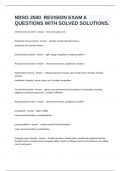NRSG 2500 REVISION EXAM 6
QUESTIONS WITH SOLVED SOLUTIONS.
Central nervous system - Answer brain and spinal cord
Peripheral nervous system - Answer includes cranial and spinal nerves
autonomic and somatic systems
Occipital lobe function - Answer sight, image recognition, image perception
Temporal lobe function - Answer short term memory, equilibrium, emotion
Parietal lobe function - Answer initiating voluntary muscles and sensation from muscles and skin,
hearing
evaluation of weight, texture, temp, etc. for object recognition
Frontal lobe function - Answer speech, eye movement and orientation, concentration, planning
judgment, emotional expression, creativity, inhibition
Temporal lobe function - Answer short-term memory, equilibrium, emotion
sympathetic - Answer fight or flight
main neurotransmitter is norepinephrine
parasympathetic - Answer controls mostly visceral functions
main neurotransmitter is acetylcholine
Assessing neuro function - Answer Cerebral function- mental status, intellectual-cognition function,
thought content, emotion status, language ability, impact on lifestyle, level of consciousness, perception,
motor, and speech
,Cranial nerves- sensory, motor, or mixed nerves
Motor system- posture, gait, muscle tone and strength, coordination and balance
Sensory system- tactile sensation, superficial pain, vibration and position sense
Reflexes- gag, corneal, plantar (Babinski), and deep tendon
Assessment of altered mental status - Answer Level of consciousness (LOC) is the most important
indicator of the patient's condition
Glasgow Coma Score (GCS) 3-15
Pupils - round and reactive
Motor- symmetry vs asymmetry
Sensation-numbness, tingling, painful stimuli
Speech- aphasia (receptive, expressive, global), slurred
Voluntary vs. involuntary reflexes
Cranial nerve I: Olfactory - Answer sensory - sense of smell
Cranial nerve II: Optic - Answer sensory - visual acuity and fields
Cranial nerve III: Oculomotor - Answer motor - muscles that move the eye and lid, pupillary
constriction, lens accomodation
Cranial nerve IV: Trochlear - Answer motor - muscles that move the eye
Cranial nerve V: Trigeminal - Answer Mixed - facial sensation, corneal reflex, mastication
Cranial nerve VI: Abducens - Answer motor - muscles that move the eye
Cranial nerve VII: Facial - Answer mixed - facial expression and muscle movement, salivation, tearing,
taste
, Cranial nerve VIII: acoustic - Answer sensory - hearing/equilibrium
Cranial nerve IX: glossopharyngeal - Answer mixed - taste, swallowing
Cranial nerve X: Vagus - Answer mixed - muscles of the pharynx, larynx, sensation in external ear,
pharynx, larynx, thoracic and abdominal viscera, parasympathetic innervations of thoracic and
abdominal organs
Cranial nerve XI: Spinal accessory - Answer motor - sternocleidomastoid and trapezius muscles
Cranial nerve XII: hypoglossal - Answer motor - movement of the tongue
Level of consciousness - Answer is a continuum from normal alertness and full cognition to coma.
Altered LOC is no the disorder but the result of pathology
Akinetic mutism - Answer unresponsiveness to the environment, makes no movement or sound but
sometimes opens the eyes
Persistent vegetative state (irreversible coma) - Answer devoid of cognitive function but has sleep
wake-cycles, swallow, cough, eye movement
Locked-in syndrome - Answer alert and aware, but inability to move or respond except for eye
movements due to a lesion affecting the pons, communicate by blinking
Brain death - Answer cessation and irreversibility of all brain functions, including brain stem
Glasgow coma score - Answer GREATER THAN 8 = INTUBATE
is calculated by using appropriate stimuli (a painful stimulus may be necessary) and then assessing the
clients response in three areas.
Eye opening (E) - The best eye response, with responses ranging from 4 to 1




